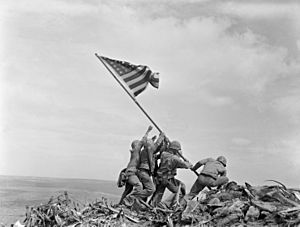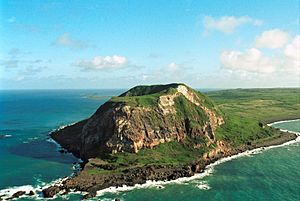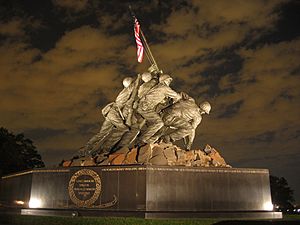Joe Rosenthal facts for kids
Quick facts for kids
Joe Rosenthal
|
|
|---|---|

Rosenthal in 1990
|
|
| Born |
Joseph John Rosenthal
October 9, 1911 |
| Died | August 20, 2006 (aged 94) Novato, California, U.S.
|
| Occupation |
|
| Known for | Raising the Flag on Iwo Jima photograph |
| Awards | Pulitzer Prize Navy Distinguished Public Service Award |
Joseph John Rosenthal (born October 9, 1911 – died August 20, 2006) was an American photographer. He won the Pulitzer Prize for his very famous World War II photo. This picture is called Raising the Flag on Iwo Jima. He took it during the 1945 Battle of Iwo Jima. His photo became one of the most well-known pictures from the war. It was even used to create the Marine Corps War Memorial in Arlington, Virginia.
Contents
Early Life of Joe Rosenthal
Joseph Rosenthal was born in Washington, D.C., on October 9, 1911. His parents were immigrants. He became interested in photography as a hobby. This happened during the Great Depression, a time when many people had little money.
He finished McKinley High School in 1929. After working as an office boy, he moved to San Francisco. There, in 1932, he became a reporter and photographer for The San Francisco News.
Joe Rosenthal and World War II
The U.S. Army did not accept Rosenthal as a photographer. This was because he had poor eyesight. In 1941, he studied at the University of San Francisco. He then joined the Associated Press (AP), a news agency.
In 1943, he worked for the United States Maritime Service. He was a photographer, documenting life on ships. He served in the British Isles and North Africa. In 1944, he went back to the Associated Press. He followed the United States Army and U.S. Marine Corps in the Pacific Ocean. He was a war correspondent in places like Hollandia, New Guinea, Guam, Peleliu, Angaur, and Iwo Jima.
The Famous Flag-Raising Photo
On February 23, 1945, Marines had been fighting on Iwo Jima for four days. Rosenthal was visiting the island when he heard exciting news. An American flag was being raised on Mount Suribachi. This was a volcano at the island's southern tip.
Rosenthal quickly headed towards Suribachi. He carried his large Speed Graphic camera. This was a common camera for news photographers then. He climbed the mountain with two Marine photographers. These were Pvt. Bob Campbell and Sgt. Bill Genaust.
About halfway up, they met Staff Sgt. Louis Lowery. Lowery was a photographer for "Leatherneck Magazine". He was coming down the mountain. An enemy grenade had exploded, breaking his camera. Lowery told them that a flag had already been raised. He had taken pictures of it. But Lowery also said the view from the top was good. So, Rosenthal convinced Genaust and Campbell to keep going up with him.
At the windy top of Mount Suribachi, Rosenthal saw a group of Marines. They were attaching a larger flag to a steel pipe. He saw the smaller flag flying nearby. He even got his picture taken under the first flag by Campbell.
Another group of Marines was getting ready to lower the smaller flag. At the same time, the larger flag was being raised. This was done under an officer's orders. Rosenthal thought about trying to photograph both flags at once. But he wasn't in the right spot. (Pvt. Campbell did get a picture of the first flag coming down as the second went up). So, Rosenthal focused on the men raising the second flag.
Rosenthal piled up stones and a sandbag to stand on. He was only about 5 feet 5 inches tall. He set his camera's lens and shutter speed. Then, he saw six Marines begin to raise the second flag. He quickly turned his camera and pressed the shutter button. Just three feet away, Sgt. Genaust filmed the flag-raising in color.
To make sure he had a good photo, Rosenthal took another picture. This one showed four of the flag-raisers steadying the flagstaff. After that, Rosenthal gathered 16 Marines and two Navy corpsmen. He took a posed photo with them around the flagstaff. This picture is called the "Gung Ho" photo.
The Impact of the Flag-Raising Photo
Americans saw Rosenthal's photo as a powerful sign of victory. News services quickly sent the picture around the world. It appeared in Sunday newspapers on February 25, 1945. (Lowery's photos were not released until 1947). Many magazines put the photo on their covers.
After the Battle of Iwo Jima was won, the photo was used for posters. These posters helped sell war bonds in over 30 cities. The bond drives raised $26.3 billion.
Rosenthal's photograph became a lasting symbol. Artists used it to create the Marine Corps War Memorial (1954). This memorial is often called "The Iwo Jima Memorial". It is located in Arlington, Virginia. The U.S. Postal Service also put the photo on a postage stamp. A smaller version of the memorial stands at Marine Corps Recruit Depot Parris Island.
Later Years and Death
In his later years, people often asked Rosenthal about the photo. He would simply say, "I took the picture, the Marines took Iwo Jima."
Rosenthal left the Associated Press in 1945. He became the chief photographer and manager for Times Wide World Photos. Later, he joined the San Francisco Chronicle newspaper. He worked there as a photographer for 35 years. He retired in 1981.
In 1982, his name was carved into the Marine Corps War Memorial. On April 13, 1996, Rosenthal was named an honorary Marine. This was a special honor given by General Charles C. Krulak.
Joe Rosenthal passed away on August 20, 2006, at age 94. He died peacefully in his sleep in Novato, California. This area is in northern Marin County. Rosenthal was cremated. A Marine Corps ceremony was held for him on September 15. A Catholic funeral mass was held on September 16, 2006. Both services took place in San Francisco, California.
Awards and Honors
The International Museum of Photography and Film in Rochester, New York displays the camera Rosenthal used.
- Pulitzer Prize: Rosenthal won the Pulitzer Prize in 1945. The committee said the photo showed "one of the war's great moments." They called it a "frozen flash of history."
- International Photography Hall of Fame: He was honored in St. Louis, Missouri.
- Navy Distinguished Public Service Award: The United States Marine Corps gave Rosenthal this award after he died. This happened on September 15, 2006. The award recognized his amazing public service. His photo showed the American fighting spirit during World War II. It became a symbol of service and sacrifice.
Legacy
The 2006 Hollywood movie Flags of Our Fathers was directed by Clint Eastwood. It tells the stories of the American flag raisers. It also shows Rosenthal's part in taking the famous photo. Actor Ned Eisenberg played Rosenthal in the film.
Reporters interviewed Rosenthal a lot after September 11, 2001. This was when Thomas E. Franklin took a similar famous photo. It was called Ground Zero Spirit. It showed firefighters raising a flag at the World Trade Center. Rosenthal and Franklin met several times after this event.
See also
 In Spanish: Joe Rosenthal para niños
In Spanish: Joe Rosenthal para niños




